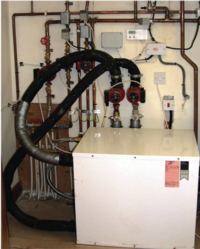Underfloor heating and renewables make for a perfect partnership

The low flow temperatures associated with underflooor heating work particularly efficiently when partnered with ground-source heat pumps.
Using renewable energy can reduce carbon emissions and deliver savings on fuel bills.
Bill McConnel explains how underfloor heating can reinforce these energy efficiencies.Renewable energy occurs naturally and is in effect ‘perpetual’ in the environment. Solar energy is the most common form of renewable being used directly in solar, thermal and photo-voltaic systems. It is also used indirectly by heat pumps, wind energy and biomass boilers. So why is underfloor heating (UFH) proving so popular for use with renewable energy sources? Significantly, it complements the technology. UFH uses less energy for distribution because the flow and return temperatures can be kept considerably lower than those of a traditional radiator system. Also, since the method of heating is primarily radiant — from the floor upward — rather than convective, people feel warmer at a lower air temperature (typically 1 or 2 K) than with a traditional convective radiator heating system. In a room having a heat loss of 2 kW with an internal temperature of 21°C and an external temperature of –3°C, the heat loss could be reduced by up to 8% due to the radiant effect of UFH.
Heat pumps The low flow temperatures in UFH work particularly efficiently when partnered with ground-source (GSHP) and air-source (ASHP) heat pumps. The coefficient of performance (COP), of these devices is crucial to achieving energy savings and payback period of the installation. The best way to increase COP is to try to ensure that the discharge water flow from the heat pump is matched as closely as possible to the source temperature. For instance, with a COP of 4 and a ground temperature typically between 0 and 10°C in the UK during winter, the flow temperature of the heated water produced by the GSHP is 30 to 35°C, which is ideal for a UFH system, but too low for radiators without additional electric or boiler heating. Insulation levels of the building should conform to or exceed Building Regulations so as to enable the flow temperature of the UFH system to be kept as low as possible, increasing the efficiency. There is a direct relationship between the surface temperature of the floor and the air temperature of the room. For example, if the heat output of the underfloor heating needs to be 90 W/m2 and the room air temperature 20°C, the floor temperature would need to be about 28.5°C. In modern buildings, typically, the heat loss is frequently nearer 50 W/m2 or less. This means that the surface temperature of the floor is much closer to the air temperature, which gives underfloor heating a shorter reaction time. This has an added advantage because heat pumps can be used at potentially lower tariff rates overnight, and provide enough energy in the screed to be gently released during the day. During cold snaps, the heat pump can be programmed to boost the system during the day.
Renewable energy A growing trend is to use a combination of renewable energies to provide both space heating and hot water — for example, using GSHPs and solar thermal systems. It is technically feasible to use the excess heat generated by solar panels or tubes in the summer to ‘top up’ the heat available in a GSHP borehole by pumping the excess hot water down into the borehole. This helps to ensure that the stabilised temperature in the borehole is higher during the winter than it would otherwise be. However, the extra efficiency is hard to quantify, so my advice is to keep things simple and use the solar system for hot water and the GSHP for space heating, or to link the systems with a thermal store. Wind power can be used to offset the electrical cost of running the heat pump. If 20 kW of heat is supplied by an underfloor heating system via a GSHP with a COP of 4, a 5 kW wind turbine could, in theory, supply all the power requirements for the heat pump. Unfortunately this is not really feasible since the wind turbine will rarely work at full power due to fluctuating wind conditions. Also, many heat pumps require significant starting currents, which a wind turbine would be unable to provide. However, wind power can be used to considerably reduce the cost of running the heat pump by exporting electricity back into the national grid.
Biomass Also growing in popularity are biomass boilers using wood pellets or wood chips. These boilers are becoming increasingly more sophisticated, some offering high levels of modulation. Biomass boilers are usually installed with buffer tanks or heat stores, a simple device that enables them to be used with UFH to offer another efficient heating option. Underfloor heating, by its very nature, is more efficient than many traditional methods of space heating. Used with renewable energy sources, UFH helps to improve energy efficiency and reduce the carbon footprint of a building — and, best of all, keeps it all simple.
Bill McConnel is technical director with Continental Underfloor Heating
Related links:


